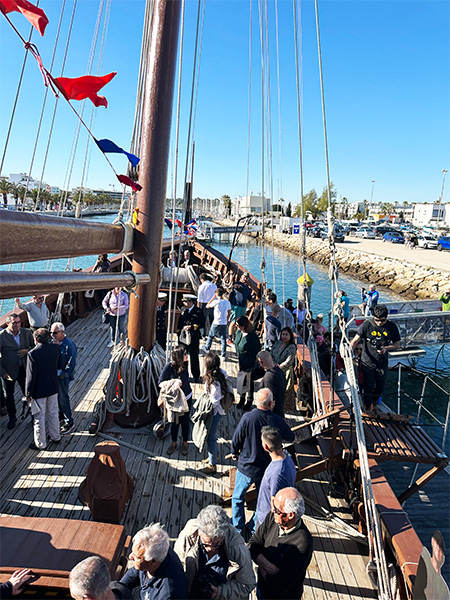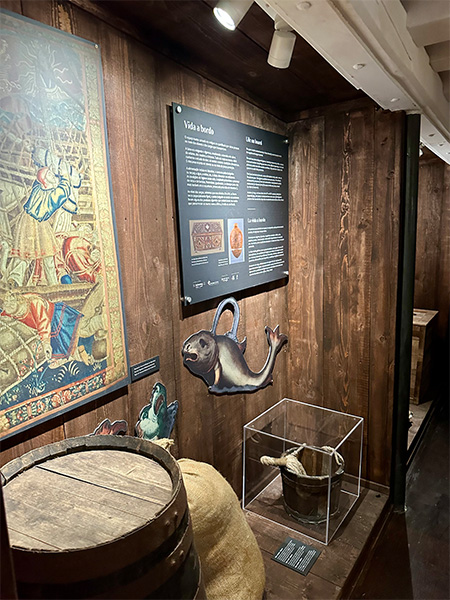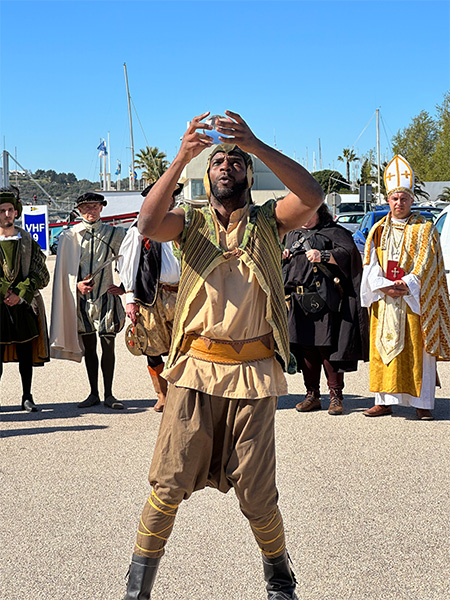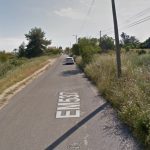In March this year, the restored 15th-century caravel Boa Esperança in Lagos was inaugurated with great pomp and circumstance. After years of neglect, the caravel had undergone a complete refurbishment at the Portinave shipyard in Portimão. The enormous efforts made by all stakeholders paid off when it was opened to the public, ready for a new chapter.
An expectant crowd had gathered by the quayside of the fishermen’s harbour where the caravel is stationed. We were offered refreshments in a marquee and enjoyed live music, juggling acts and watching historical enactments in front of the ship.
The ceremony was attended by Hugo Pereira, the Mayor of Lagos Municipal Council, João Fernandes of the Algarve Tourism Board and José Fernández de Cabo, a representative of Fundación Nau Victoria, the Spanish collaborators. In the crowd, I also spotted Captain José Gravata, crew members and volunteers smiling broadly. It was a proud day for all involved.
Hugo Pereira outlined the new role of the caravel. As an Interpretive Centre for Boa Esperança and the Portuguese Discoveries, it would become “an emblematic asset, promoting an important historical period of humanity”. He added, “We have been working for a long time to promote Lagos as not just a beach resort but to show it has a cultural and historical element. Through the caravel that can be visited, it is possible to appreciate the importance they played.”


João Fernandes of the Algarve Tourism Board also stressed the regional tourism implications. “We hope to turn the caravel into a dynamic hub of cultural tourism, which values our region’s heritage and preserves the cultural memory of Lagos and the Algarve.”
He explained that the name Boa Esperança came about as it managed to sail around the Cape of Good Hope, also known as the Cape of Torments, with many sailors losing their lives in the turbulent waters. “We had to overcome a true Cape of Torment to make it here today,” he said to general applause.
In 1488, the explorer Bartolomeu Dias achieved a milestone in Portuguese explorations in a caravel identical to this. Against all odds, he discovered the passage around the Cape, making it possible for the Portuguese to trade directly with India and the Far East. The present replica is a prime example of the early caravel with its two masts and lateen sails to facilitate navigation against the wind. It carries the symbol of the Cross of Christ, harking back to Henry the Navigator, who was the Regent and Governor of the Order of Christ.


The Boa Esperança replica was built in Vila do Conde in northern Portugal by naval specialists using archaeological finds from caravels in Aveiro and the Tagus River and drawings from museum archives. It was completed on 28 April, 1990. In 2001, the Algarve Tourist Board acquired the caravel.
Its inaugural voyage was to Bruges to commemorate the anniversary of the first trading post of the Portuguese in the early 15th century. It has visited innumerable ports in northern Europe and the Mediterranean, participated in several regattas here and in the North Atlantic, attended the Queen’s Jubilee in London and represented the Algarve as the ship of honour at the Festival of Cannes, to name but a few.
However, due to a lack of investment and uncertainty about its mission, the caravel became increasingly rundown. A sorry sight for a long time, it was moored in Lagos, awaiting its fate. That is until now.
Now visitors can step on board into the world of the 15th-century explorers and appreciate the reality of life on a small ship that undertook hazardous voyages across unknown seas.


Visit Boa Esperança:
Below the deck, you can see exhibitions showing everyday life on board and explaining the significance of the discoveries, as well as maps outlining routes. Using 21st-century technology, you can even enter the virtual world of the 15th century! A free app ‘Boa Esperança Caravel’ (for Android and iOS systems), that enhances the experience in the virtual reality of crew members is available to download. The app can also be used when exploring Lagos with interactions and information about places related to Portuguese Discoveries.
Also, onboard, it’s possible to view a 13-minute video documentary by New Light Pictures about the role of caravels in Portuguese history. Available in English, Portuguese and Spanish, it is well worth watching.
The Boa Esperança interpretation centre is open from Tuesday to Sunday between 10 am and 6 pm. The Lagos Ciencia Viva manages the visits. There is an entrance fee.
To book a visit:
+351 282 770 000
+351 969 685 985













